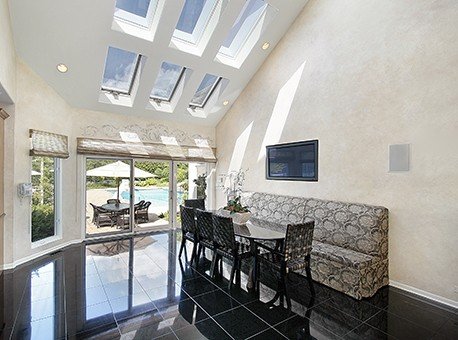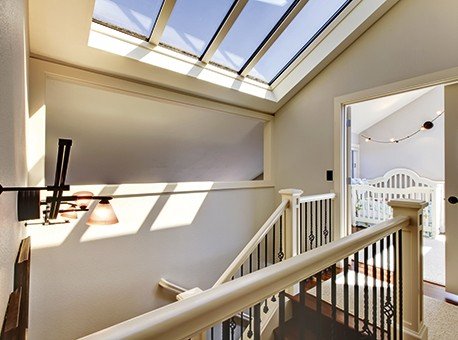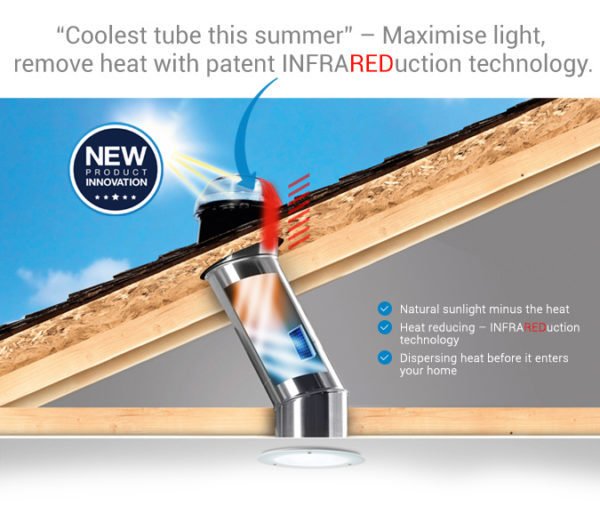The very short answer to this question is yes, as natural light carries heat in the form of infrared radiation, however the amount of infrared transferred into the home will depend on the technology used in the skylight. A similar comparison can be made with different electric light technologies, where incandescent globes generate a lot of heat, while LED lights improved this issue and are cool enough to touch. Differences in how skylights handle heat can be just as distinct.
There are a number of techniques commonly used in the market to reduce or remove heat entering the home. These methods can be as simple as pulling down a blind or shutter, which does reduce the heat transfer into the home but also cuts out the light. Other techniques or technologies include:
- Levels of glazing – The most common way of reducing heat in a skylight is through glazing layers. We’ve all heard of double glazing or triple glazing in windows – the same technique can be used for skylights in both glass and plastic options. While this is a very common solution for temperature control, each level of glazing reduces the amount of light that enters the building. This can have a negative impact away from the original aim of installing a skylight – which is to bring natural light into a space.

- Skylight tinting and window films – Another way to remove heat is with films or tinting. This is more common in car windows, but is also common in skylights which have darker or opal coloured domes. While tinting can be more selective and targeted with the light that passes through, this will impact on the end result with less light.
- Patented INFRAREDuction technology – Solatube Australia have developed and patented their own technology that specifically focuses on removing infrared rays (heat) that enters the skylight. While 99.97% of the visual light is reflected down the tube, infrared rays are absorbed out of the tube before they can transfer through to the interior. This technology makes our Brighten Up series Daylighting Systems Australia’s coolest skylight, while still providing the most natural light.
To understand the actual performance of products in the skylight industry, third party testing methods have been developed to measure the heat and light transmitted though different products. The measurement for heat transferred through the material in Skylights is called the Solar Heat Gain Coefficient (SHGC) and the method for measuring transmitted light is called Visual Transmittance or VT. The highest energy efficiency in a skylight is achieved with an optimum ratio of high light output versus low heat gain. One other energy efficiency issue to consider (particularly in cooler climates, but also in hotter climates where air-conditioning costs are high) is the U-factor. This third measurement used for skylight energy efficiency, measures the amount of air that passes through the product. In simple terms this measures the amount of heat lost through the skylight during winter when you are trying to heat up the home.
Lastly, there are a lot of energy efficiency claims made in Australia, not all of them accurate. Consumers and energy efficiency conscious designers and architects should check that products have been tested. The following sites are a good resource.
https://www.wers.net/werscontent/certified-products-hub
https://search.nfrc.org/search/Searchdefault.aspx
If your selected products do not appear on one of these listings, the testing completed has not been approved by a regulatory body that can monitor and audit the quality or components used to achieve the energy efficiency rating.




My brother and I were planning to make some upgrades to his beach house before vacation starts. I found it interesting when you stated that glazed skylights are a common solution to reduce heat because we had planned to have some of them installed but my brother brought up the concern of the potential heat that the direct sunlight might bring into the house. I’ll be sure to show your article to my brother so he has a better idea of what to get installed. Thank you!
Thanks Afton
Glad we could help, if you would like the local Premier Dealer information for you area, just fill in your postcode on this page. https://solatube.com.au/solatube-premier-dealers/
Can solatubes work through a 2 story house?
Hi Gary,
Yes they can, best idea would be to speak with the local Dealer to provide advice. If you type your postcode into this link it will give you Dealer contact details. https://solatube.com.au/solatube-premier-dealers/
Can you avoid heat transfer via solar tube in a flat metal deck roof?
Hi Judy,
The DS Series Skylights has technology that reduces the heat. https://solatube.com.au/the-miracle-skylight/
We live in a cold area. Our outdoor area is very dark. The decks roof is the same as the house. Colourbond roofing. Can we put a skylight in or something you suggest. Cheers Karen
Hi Karen
Best idea is to speak with the local Dealer to see what is possible for your home, if you type in your postcode to this link will take you to the closest Dealership. https://solatube.com.au/solatube-premier-dealers/